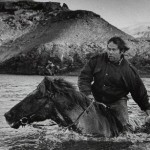by Adrienne Mayor (regular contributor)
According to the ancient Greeks, nomadic Scythians and Amazons beyond the Black Sea were the first to tame wild horses. Recently translated oral traditions of tribes of the northern Caucasus affirm that ancestral superheroes called “Narts” were the first to ride wild horses. (Nart sagas combine ancient Indo-European mythology with Eurasian folklore.) Notably, modern scientific, historical, and archaeological evidence indicates that the earliest domestication of the horse occurred on the Eurasian steppes in about 3,500 BC.
A Nart saga from Abkhazia (NW Caucasus) credits a folk hero, Sasruquo, with the discovery of a unique method of taming a headstrong horse. In the tale, Sasruquo needs to travel quickly to an important assembly of many tribes. This was in the time when only the Narts knew the secrets of domesticating wild horses. But after his beloved horse Bzow died, Sasruquo had vowed to “sit astride no other steed.”
He sets off on foot but must cross a furiously churning river. He notices a wild stallion grazing on the bank. Sasruquo makes reins and a bit of mulberry bark, thrusts it into the horse’s mouth, and leaps onto the stallion’s back as it plunges into the river. As the horse thrashes and wears itself out against the raging torrent, Sasruquo patiently urges and guides the stallion to safety on the other bank. The horse, now docile, trusts Sasruquo and follows the direction of the reins.
At the assembly of tribes, people are astonished to see someone riding horse and they asked how the feat was accomplished. “From that day onward,” many nomads on the steppes began to tame and ride wild steeds.
This resourceful ancient technique of teaching horses to accept riders is still used by horse-people in the Caucasus and the steppes–and in other places around the world. Some mount horses in streams or rivers; others start riding young or wild horses in deep snow banks. In the Altai region and Mongolia, they train young and/or wild horses by riding them in deep mud or over hillsides. Native Americans and ranchers in the US have used these methods, too. All the versions have the same effect of impeding and tiring the horse. The method should be not be overdone, and the river technique works best if one uses herd instinct, allowing a young or green horse to observe and follow other horses into water, before introducing a rider.
About the author: Adrienne Mayor is a research scholar in Classics and History of Science, Stanford University. Her most recent book is The Amazons: Lives and Legends of Warrior Women across the Ancient World (Princeton UP 2014)
Acknowledgments: See Saga 81 in John Colarusso’s Nart Sagas of the Caucasus (coming out in paperback 2016). Thanks to knowledge shared by Min Andersen, Lisa Badger, Roberta Beene, Deborah Farvoyager, Scott German, Nolan Gillies, Julie Kinney, Patricia Marinelli-Siutz, Diana Olds, Katie Stearns, Linda Svendsen, and other members of the Amazons Ancient and Modern group on Facebook https://www.facebook.com/groups/ancientamazons/
